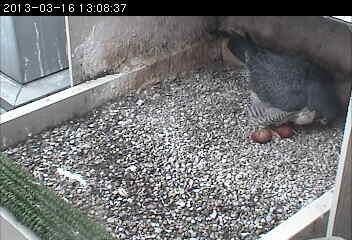
This afternoon at the Cathedral of Learning Dorothy laid her second egg at 1:08pm.
“Pitt Peregrines” made a video of this one, too.
(photo from the National Aviary snapshot camera at the University of Pittsburgh)

This afternoon at the Cathedral of Learning Dorothy laid her second egg at 1:08pm.
“Pitt Peregrines” made a video of this one, too.
(photo from the National Aviary snapshot camera at the University of Pittsburgh)
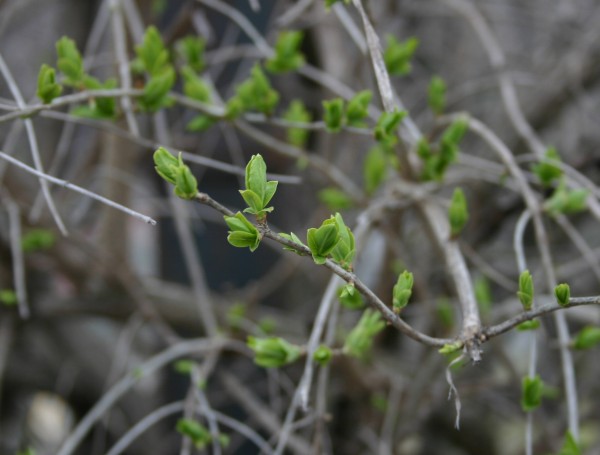
Just in time for St. Patrick’s Day…
The first plant to open leaves in my neighborhood is always the invasive bush honeysuckle across the street. Though I’m not fond of the species I’m always happy to see these particular bushes green up. They’re one of my signs of Spring.
Yesterday, March 15, was the first time the leaves were green enough to see at a distance.
A year ago the hot weather put us well beyond honeysuckle leaves and into magnolia flowers by this date.
Here’s a picture from March 16,2012.
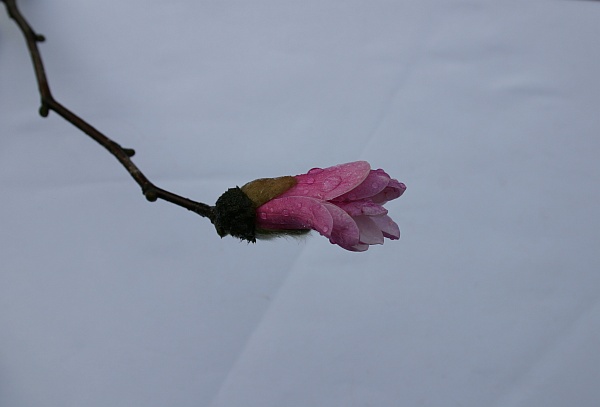
Frankly, I’m quite happy we’re having a normal spring.
(photos by Kate St. John)
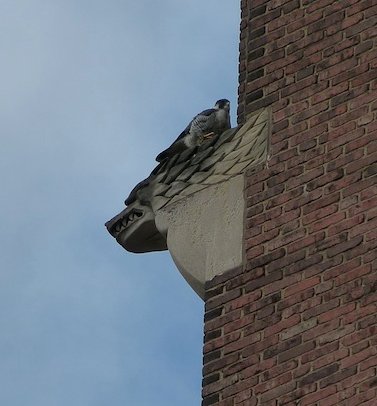
Thanks to Downtown peregrine watcher Kim Fox and Lawrence Hall resident Amanda McGuire, I have news and photos of Louie and Dori.
Kim was Downtown at lunchtime yesterday when she heard and saw a peregrine on the left gargoyle at Lawrence Hall (above). He was calling. You might call it “screaming.” Louie is one loud bird!
Unseen by Kim, Dori was waiting for him in the nest area and responding to his calls. Soon he left his perch…
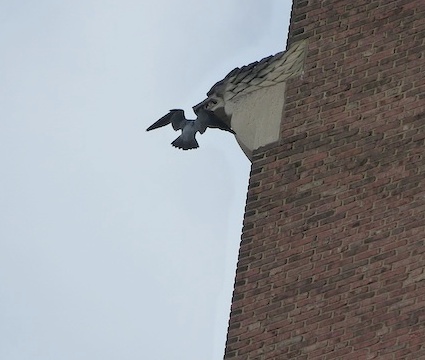
…and flew into the nest nook.
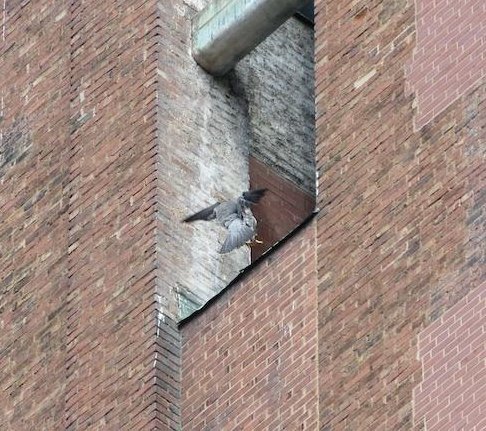
…where he and Dori had a private conversation that no one could see. We know it involved bowing.
As soon as they were done, Louie flew away and Dori came to the edge. Nice photo, Kim!
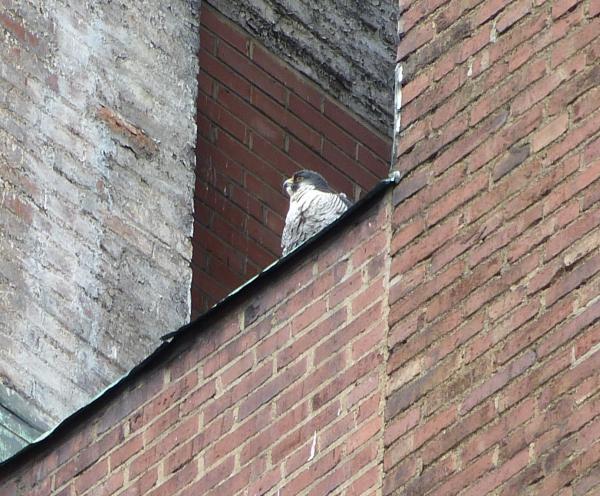
Where did Louie go when he left the nest? Amanda McGuire knows. She lives in the apartment whose balcony is the peregrines’ favorite perch. (Katie Munsch lived there last year.)
Amanda returned to her apartment at 12:15pm and heard a bird screaming on her balcony. It was Louie, of course. She took this picture of him through her screen door so he wouldn’t fly away.
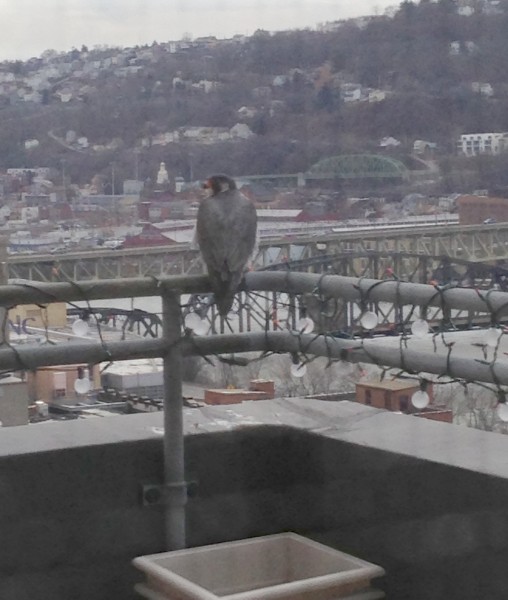
She probably didn’t have to worry about that. Louie and Dori have been so preoccupied that they come and go from her balcony as if they own it.
They’re courtin’ up a storm. Eggs coming soon!
(photo of Louie on the balcony by Amanda McGuire, all other photos by Kim Fox, WorkerBird)
p.s. I call these birds Louie and Dori but we have no proof that they’re the same pair. Downtown Peregrine Watchers, we need photos! Let me know what you see.
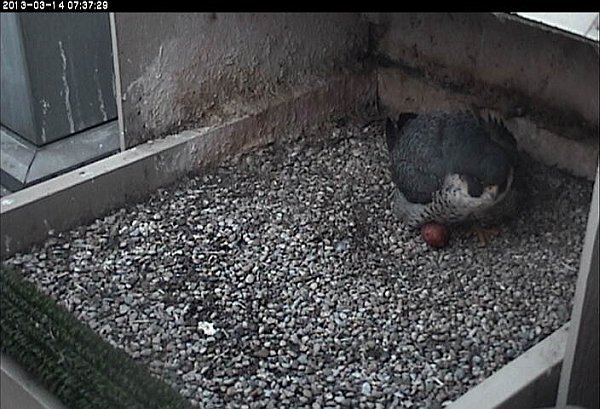
Here’s Dorothy at dawn with her first egg of 2013. She laid it last evening at 6:42pm. (See yesterday’s post, including video.)
Today I’ll post pictures of interest as they become available. Stay tuned.
E2 arrives to see his first egg:
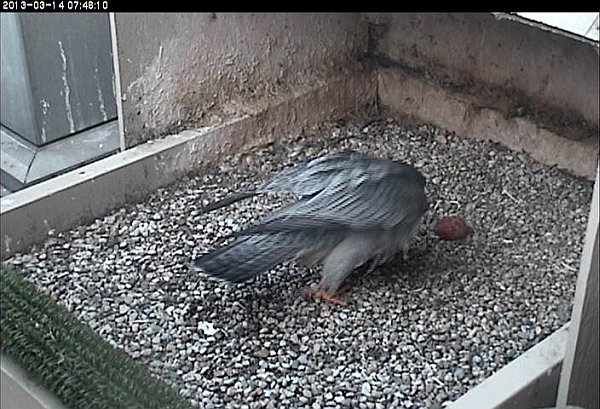
E2 shelters the egg:
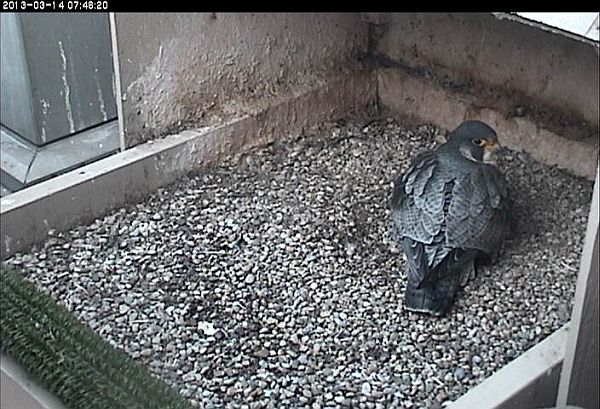
Dorothy spent half an hour eating, then came back and spent the rest of the morning at the nest. At 11:46am E2 came to give her a break. They did a little courting over the egg.
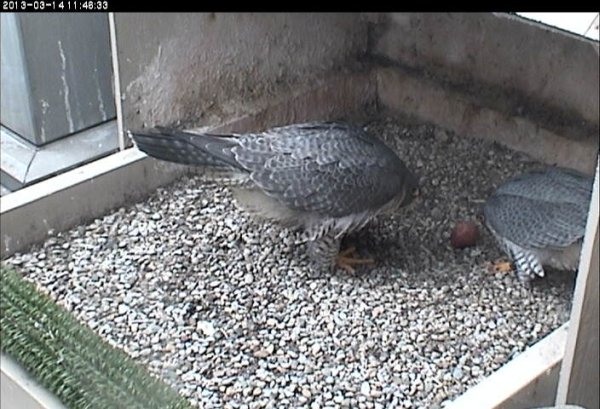
And then she took a break.
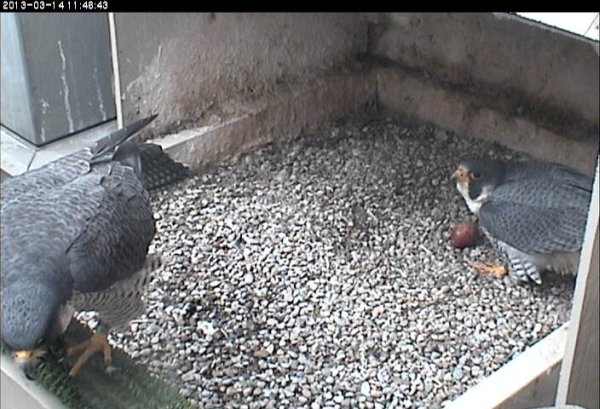
More later…. of course!
(photos from the National Aviary snapshot camera at the University of Pittsburgh’s Cathedral of Learning)
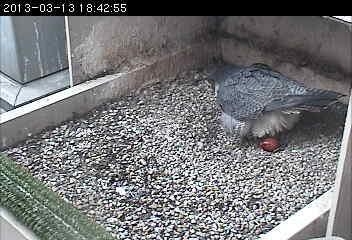
At Pitt’s Cathedral of Learning, Dorothy laid her first egg of 2013 this evening, March 13, at 6:42pm.
Thanks to Peter Bell for capturing this image from the snapshot camera.
Also see this video on YouTube posted by “Pitt Peregrines”:
A NOTE ABOUT THE PEREGRINE FALCON WEBCAMS:
Yes, the live video camera at Dorothy’s nest is blurry.
We installed a new camera in late January hoping for better color and focus. Unfortunately condensation has formed inside the housing — probably a manufacturing flaw. We cannot fix or replace the camera right now. Dorothy is nesting and we are not allowed to disturb her. The good news is that this camera has a microphone so you can hear what’s going on. Click here for the streaming camera with audio.
The snapshot camera is a second camera on the nest. It produces a photo every 15 seconds at this link. If you right-click on the photo and choose “Save As” you can save the snapshot pictures. That’s how Peter got a photo of Dorothy laying her first egg.
(photo from the National Aviary snapshot camera at the University of Pittsburgh’s Cathedral of Learning)
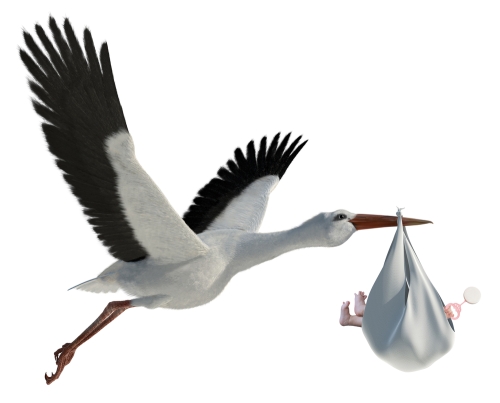
13 March 2013
We’ve all heard the story that storks bring babies. It was Grandma’s easy to answer to “Where do babies come from?”
The legend began where white storks nest in northern Europe, often in close proximity to humans. Their care for their young made them symbols of parental devotion. Slavic folklore held that storks brought unborn souls from paradise to earth in the spring and summer. That’s when the storks returned to northern Europe from their long migration to Africa.
But in the past 30 years many of them have stopped migrating. Large numbers are hanging out in Spain and Portugal. In 1995 there were 1,108 winter storks in Portugal. By 2008 there were 10,000. The number keeps growing and some of them never leave. Many stay year-round to raise their families.
The obvious attraction is Portugal’s landfills. Though white storks are carnivores, they love hanging out at the dump for an easy meal. Do the landfill storks merely visit for the winter? Do they move to other places in Portugal for the breeding season? And where would that be?
Researchers from the University of East Anglia have begun a one year study of stork migration. They’ve captured and tagged 15 adult white storks with satellite monitors to transmit each stork’s location and activity five times per day. The tags are smart enough to record whether the stork’s head is down in a feeding position.
The study is coming at a good time for the birds. In the 20th century white storks declined so badly that they had to be reintroduced in some countries. Now they’ve made a comeback at the dumps but Portugal is slowly replacing its open landfills with covered facilities to process waste food. Where will the storks go?
The study is important for Grandma, too. If the storks don’t leave Portugal, they won’t be bringing babies to Northern Europe anymore. Uh oh!
Read more about the stork study in this Science Daily article.
(image of a stork carrying baby from Shutterstock. Photo of a white stork by Andreas Trepte, www.photo-natur.de. Click on the photo to see the original on Wikimedia Commons)
Early this month it was scary to read Chuck Tague’s account of a brush fire that came within two miles of his Ormond Beach home.
While the fired burned in Florida I was in another fire-prone place, San Diego, listening to a speech by Dr. John Fitzpatrick of the Cornell Lab of Ornithology in which he touched on how important fire is for scrub habitats and for the survival of the Florida scrub-jay in particular.
To most of us wildfire is rare but it’s a natural cycle in scrub communities where plants, animals, and birds rely on its regular occurrence. “Regular” is important. If fire happens too often or too infrequently that’s bad too.
It has taken a while to learn this. Dr. Fitzpatrick described how they studied fire and birds at Archbold Station in Highlands County, Florida. For two decades Archbold suppressed fires and watched the scrub-jay population surge then dangerously decline. After 20 years scientists burned small tracts and watched the scrub-jays surge again. They learned that the Florida scrub-jay’s optimal habitat is at 5-15 years after a fire. At 15 years the scrub gets too tall, the jay’s predators increase and the birds decline.
Fire is necessary. The trick in populated areas is to manage it so it happens only when and where it’s needed.
In San Diego the local government conducts brush management programs to protect homes and businesses. According to San Diego Audubon, these programs sometimes make matters worse. If workers clear away native chaparral, it not only destroys endangered bird habitat but results in fire-prone grassy weeds that burn more easily. Proper management of native habitat actually lowers the risk of explosive fire.
So though we fear it, fire is important. Without it we wouldn’t have Florida scrub-jays, California gnatcatchers and coastal cactus wrens, to name a few.
(photo of a helicopter dropping water on a California wildfire, by FEMA via Wikimedia Commons. Click on the image to see the original.)
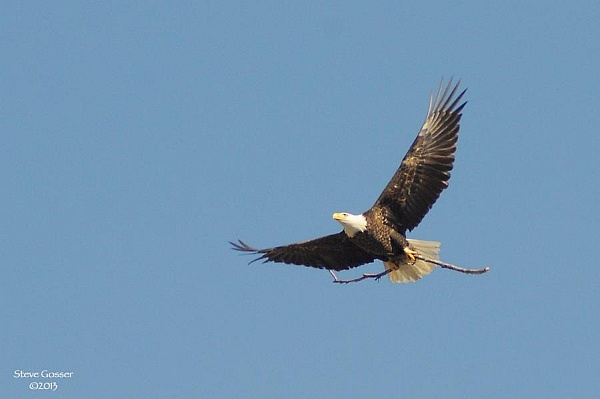
11 March 2013:
Bald eagles are the talk of the town in Pittsburgh right now.
This month a nesting pair attracted attention at the Allegheny River in Harmar Township. Steve Gosser photographed of one of them carrying nesting material yesterday.
Last month a bald eagle nest was confirmed at the Monongahela River in Pittsburgh’s Hays Woods. Tom Moeller captured the pair in a morning conversation on March 5.
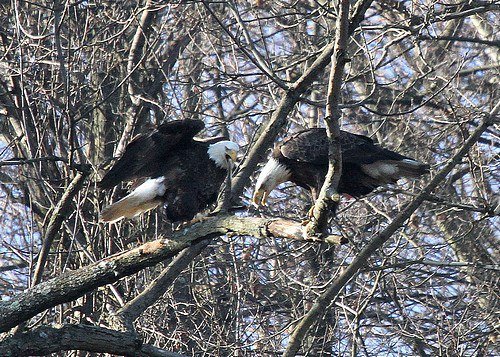
Harmar and Hays join our first bald eagle nest along the Ohio River in Crescent Township (2012) to make it three nests on three rivers in Allegheny County.
The bald eagle’s return to Pittsburgh was a long time coming. Their population crashed because of DDT and they’d been gone for decades because of water pollution. In the 1970s the U.S. banned DDT and passed the Clean Water Act. In the meantime Allegheny County’s economy changed away from heavy industry. The law and the economy together improved our water quality so that fish, the bald eagles’ favorite food, returned in good numbers.
The Hays Woods site in the City of Pittsburgh is a case in point. Eagles could not have nested there until a whole host of economic and environmental changes occurred. I know the challenges the site has faced. It has taken 30 years.
Every bald eagle nest in western Pennsylvania has a story of recovery. Thanks to the bittersweet end of heavy industry, dedicated environmental heroes, and the resilience of nature our national bird is back in town.
(photo of Harmar eagle with nesting material by Steve Gosser, photo of Hays eagle pair by Tom Moeller)

Here’s a big hawk that I’d love to see some day. He’s a native of open country in the western U.S.
The ferruginous hawk comes in two color schemes: a dark version (click here to see) and this beautiful light color. All of them have rust-colored wings, back, and legs that give them their ferruginous name.
When they fly their shape is similar to red-tailed hawks but these birds are much larger. Their scientific name, Buteo regalis, means “regal buteo.”
Here he is from below. Look how his belly appears to be bordered by rust. Those are actually his legs.
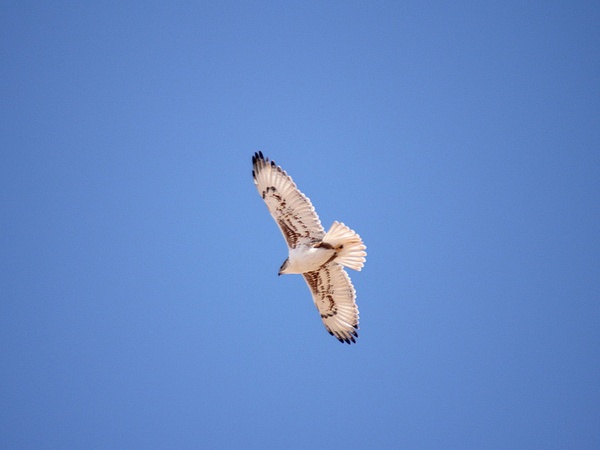
If I want to see this bird, I’ll have to travel west again. Steve Valasek took these pictures in New Mexico.
(photos by Steve Valasek)
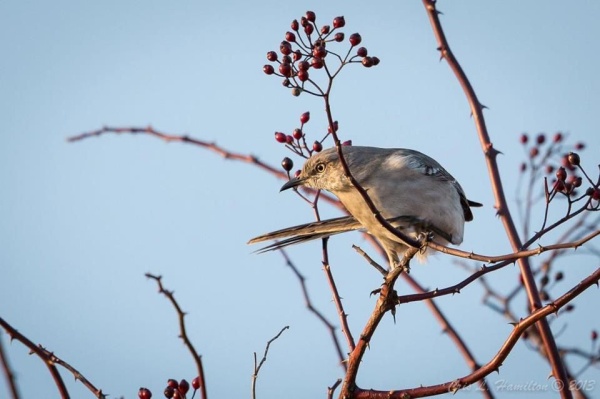
A northern mockingbird shows off his attitude.
(photo by Cris Hamilton)